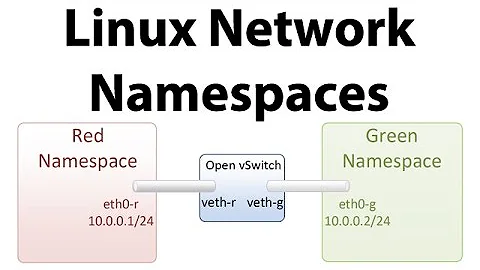How can I switch from a custom linux network namespace back to the default one?
Solution 1
Newer distros/kernels support the nsenter command which, should do what you want, providing you are root when you do it.
Here is an example (Fedora 20).
[root@home ~]# unshare -n /bin/bash
[root@home ~]# ip a l
1: lo: <LOOPBACK> mtu 65536 qdisc noop state DOWN group default
link/loopback 00:00:00:00:00:00 brd 00:00:00:00:00:00
[root@home ~]# ping google.com
ping: unknown host google.com
[root@home ~]# nsenter -t 1 -n -- ping -c 2 google.com
PING google.com (74.125.230.65) 56(84) bytes of data.
64 bytes from lhr14s23-in-f1.1e100.net (74.125.230.65): icmp_seq=1 ttl=56 time=14.2 ms
64 bytes from lhr14s23-in-f1.1e100.net (74.125.230.65): icmp_seq=2 ttl=56 time=15.0 ms
--- google.com ping statistics ---
2 packets transmitted, 2 received, 0% packet loss, time 1001ms
rtt min/avg/max/mdev = 14.239/14.621/15.003/0.382 ms
[root@home ~]# nsenter -t 1 -n -- ip a l
1: lo: <LOOPBACK,UP,LOWER_UP> mtu 65536 qdisc noqueue state UNKNOWN group default
link/loopback 00:00:00:00:00:00 brd 00:00:00:00:00:00
inet 127.0.0.1/8 scope host lo
valid_lft forever preferred_lft forever
inet6 ::1/128 scope host
valid_lft forever preferred_lft forever
2: p4p1: <BROADCAST,MULTICAST,UP,LOWER_UP> mtu 1500 qdisc pfifo_fast state UP group default qlen 1000
link/ether 10:bf:48:88:50:ee brd ff:ff:ff:ff:ff:ff
inet 192.168.1.2/24 brd 192.168.1.255 scope global p4p1
valid_lft forever preferred_lft forever
inet6 fe80::12bf:48ff:fe88:50ee/64 scope link
valid_lft forever preferred_lft forever
[root@home ~]#
This relies on the setns system call. You need at least a 3.0 kernel and glibc-2.14 for this to work.
RHEL 6.5 provides support for persistent namespaces but not support for moving existing processes into new namespaces.
Solution 2
I found that you can return to the default network namespace with two simple commands:
ln -s /proc/1/ns/net /var/run/netns/default
ip netns exec default ifconfig -a
This method obviously assumes that you can see processes outside your own namespace through the proc file system. If you are in a separate PID namespace as well, returning to the default namespace is not as simple.
The above commands were tested on Ubuntu 14.04. I don't know if there is anything distribution specific about the approach.
Related videos on Youtube
Martin
Updated on September 18, 2022Comments
-
Martin almost 2 years
With ip netns exec you can execute a command in a custom network namespace - but is there also a way to execute a command in the default namespace?
For example, after executing these two commands:
sudo ip netns add test_ns sudo ip netns exec test_ns bashHow can the newly created bash execute programs in the default network namespace? There is no ip netns exec default or anything similar as far as I've found.
My scenario is:
I want to run a SSH server in a separate network namespace (to keep the rest of the system unaware of the network connection, as the system is used for network testing), but want to be able to execute programs in the default network namespace via the SSH connection.
What I've found out so far:
Created network namespaces are listed as files under /var/run/netns (but there is no file for the default namespace)
The ip netns exec code can be found here: http://git.kernel.org/cgit/linux/kernel/git/shemminger/iproute2.git/tree/ip/ipnetns.c#n132 - I haven't grasped everything that it is doing yet, but it doesn't look very promising.
ip netns identify $$ as suggested by Howto query and change network namespace on linux? returns nothing when in the default network namespace
-
Martin almost 10 yearsThis works fine, execpt for the fact that Ubuntu provides an outdated util-linux package without nsenter. I found detailed build instructions here, however: askubuntu.com/questions/439056/…
-
copumpkin almost 9 years@kasperd you say it's not as simple with a separate PID namespace. Is it actually still possible, though? Can you mention how?
-
 kasperd almost 9 years@copumpkin I haven't tested that.
kasperd almost 9 years@copumpkin I haven't tested that. -
Pavel Šimerda over 8 yearsI tried
nsenter -t 1 -nbut it created a new process just asip netns execand didn't change the namespace of the current process. -
Sam Watkins about 2 years-1, I don't think that the
nsenter --mountoption has anything to do with networking. If I'm mistaken, please clarify.




